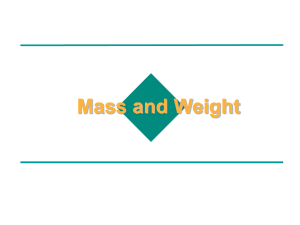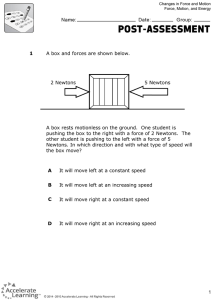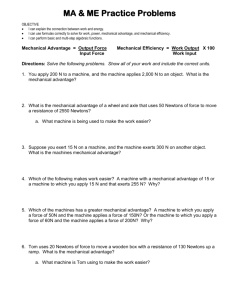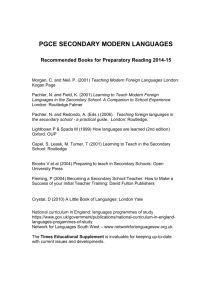Inquiry Lesson Plan: Weight
advertisement
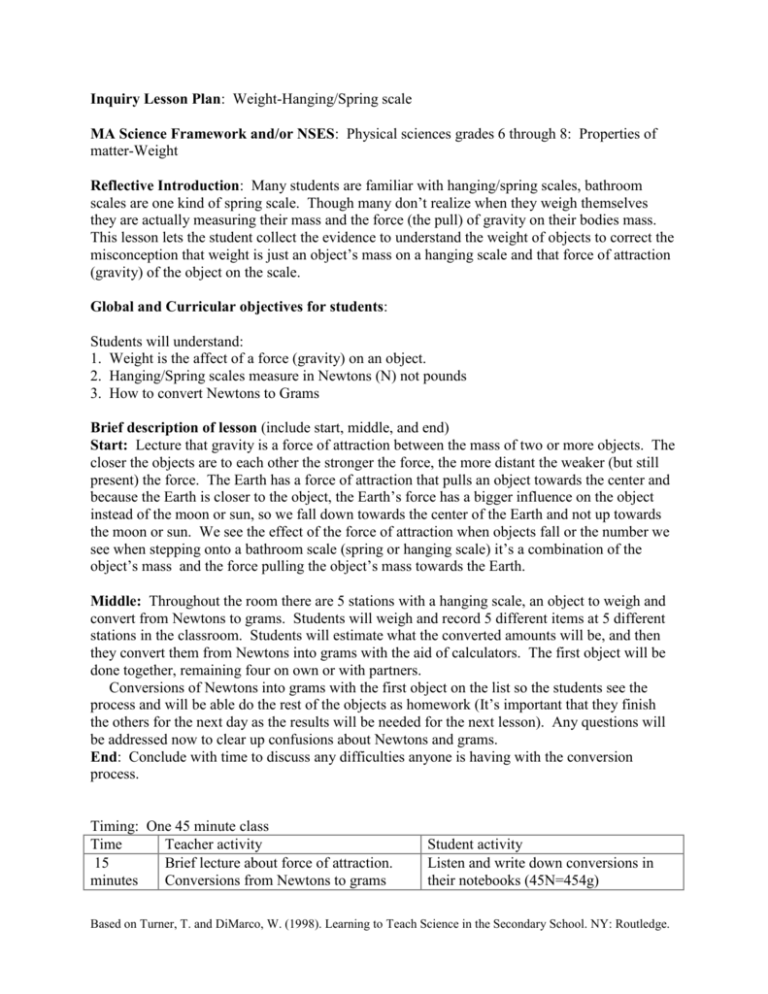
Inquiry Lesson Plan: Weight-Hanging/Spring scale MA Science Framework and/or NSES: Physical sciences grades 6 through 8: Properties of matter-Weight Reflective Introduction: Many students are familiar with hanging/spring scales, bathroom scales are one kind of spring scale. Though many don’t realize when they weigh themselves they are actually measuring their mass and the force (the pull) of gravity on their bodies mass. This lesson lets the student collect the evidence to understand the weight of objects to correct the misconception that weight is just an object’s mass on a hanging scale and that force of attraction (gravity) of the object on the scale. Global and Curricular objectives for students: Students will understand: 1. Weight is the affect of a force (gravity) on an object. 2. Hanging/Spring scales measure in Newtons (N) not pounds 3. How to convert Newtons to Grams Brief description of lesson (include start, middle, and end) Start: Lecture that gravity is a force of attraction between the mass of two or more objects. The closer the objects are to each other the stronger the force, the more distant the weaker (but still present) the force. The Earth has a force of attraction that pulls an object towards the center and because the Earth is closer to the object, the Earth’s force has a bigger influence on the object instead of the moon or sun, so we fall down towards the center of the Earth and not up towards the moon or sun. We see the effect of the force of attraction when objects fall or the number we see when stepping onto a bathroom scale (spring or hanging scale) it’s a combination of the object’s mass and the force pulling the object’s mass towards the Earth. Middle: Throughout the room there are 5 stations with a hanging scale, an object to weigh and convert from Newtons to grams. Students will weigh and record 5 different items at 5 different stations in the classroom. Students will estimate what the converted amounts will be, and then they convert them from Newtons into grams with the aid of calculators. The first object will be done together, remaining four on own or with partners. Conversions of Newtons into grams with the first object on the list so the students see the process and will be able do the rest of the objects as homework (It’s important that they finish the others for the next day as the results will be needed for the next lesson). Any questions will be addressed now to clear up confusions about Newtons and grams. End: Conclude with time to discuss any difficulties anyone is having with the conversion process. Timing: One 45 minute class Time Teacher activity 15 Brief lecture about force of attraction. minutes Conversions from Newtons to grams Student activity Listen and write down conversions in their notebooks (45N=454g) Based on Turner, T. and DiMarco, W. (1998). Learning to Teach Science in the Secondary School. NY: Routledge. 20 minutes 15 minutes 5 minutes (45N=454g) Circulate to assist students Convert the first object with the class. 45N=454g (N=kgm/sec2) Final questions, discussions and clean up Weight(N) Pair up and go to each station, weigh and record data. Listen how to do the first conversion Final questions, discussions and clean up Guesstimate(g) Actual(g) 1.) A 3-ring binder 2.) A full water bottle 3.) An empty water bottle 4.) Spiral notebook 5.) An Ipod Homework: Any conversions not finished Newtonian Density word scramble Lesson evaluation (Identify successful management, learning, enjoyment and the evidence of it. Refer to objectives. Areas for development.) Deliver effective instruction and communicates high standards and expectations throughout the lesson Manages classroom environment that is conductive to learning Student assessment (Knowledge, skills, and understanding) Point system for participation, effort and behavior: 1 point: Did not participate in activity 2 points: Participated and demonstrates adequate understanding, but with poor supporting evidence 3 Points: Active Participation and superior understanding of topic. Adjustments for special needs students: Refer to IEP Materials, equipment and supplies: Hanging/spring scales Calculators Based on Turner, T. and DiMarco, W. (1998). Learning to Teach Science in the Secondary School. NY: Routledge. Data sheet Safety concerns: None Based on Turner, T. and DiMarco, W. (1998). Learning to Teach Science in the Secondary School. NY: Routledge. Based on Turner, T. and DiMarco, W. (1998). Learning to Teach Science in the Secondary School. NY: Routledge. Courtesy of www.educationalrap.com/song/weight-mass-volume-density.html Lyrics CHORUS: Let’s discuss the difference between weight and mass People confuse it everyday in every way and let it pass Weight is the measurement of force of gravity on a matter And mass is the quantity of matter on the platter It’s easy: volume is space I’m taking, getting fatter Density is the ratio of mass to the volume in the place And this data is all you need to know So let me break it down really quickly before I go Verse 1 When you’re holding a bowling ball before you bowl it You know that there’s a force on your hand, you can’t control it It’s gravity pulling down on the mass of the ball And that force is called weight, what we’re mastering y’all But just wait: wait just a minute, man The ball doesn’t weigh 3 kilograms That’s the mass of the ball, just understand The weight is the gravitational constant known as G Multiplied by the mass of the earth Multiplied by the mass of the ball, which is 3 Divided by the radius between the center of the earth And the center of the ball squared If you’re asking, mass is a unit. It’s a quantity of matter Weight is a force that occurs when gravity happens to be present On the earth or the moon, measured with a balance, The mass is the same, cousin CHORUS Verse 2 Volume is the space occupied by a body Abide by the laws of physics just to record it Based on Turner, T. and DiMarco, W. (1998). Learning to Teach Science in the Secondary School. NY: Routledge. When you look at it, it’s easy to see The volume of a cube is the length of any side to the power of three When you wanna measure the volume of a sphere, dude Its 4/3 r You can be a beginner and still figure it out The volume of a cylinder with these steps here: The height times times the radius squared So extensively, we move on to density A measurement of mass over volume For example: the density of water is 1 g/cm So you understand It’s all a part of the plan to get the knowledge From my rhyme to your min to your hand Measure the volume of a can in simplicity With weight, mass, volume, and density Based on Turner, T. and DiMarco, W. (1998). Learning to Teach Science in the Secondary School. NY: Routledge.


